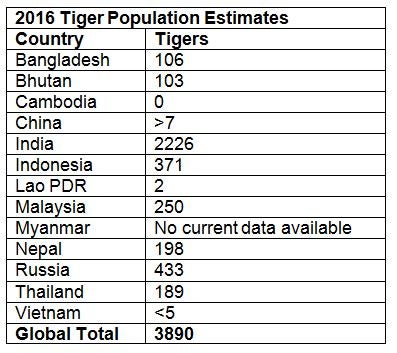This article was published in Scientific American’s former blog network and reflects the views of the author, not necessarily those of Scientific American
Tiger conservation is a story of contrasts.
Throughout Asia, wild tigers (Pantera tigris) face constant pressures from poachers, deforestation and development. We saw the worst of this last week when Cambodia declared that its tiger population had gone extinct.
Despite these ever-present threats, however, tigers have started to claw their way back in other countries, most notably India and Russia. Therein we find the other side of the story: as a whole, tiger populations are on the rise. Today, at the 3rd Asia Ministerial Conference on Tiger Conservation, officials announced that the estimated number of tigers living in the wild has increased to 3,890.
On supporting science journalism
If you're enjoying this article, consider supporting our award-winning journalism by subscribing. By purchasing a subscription you are helping to ensure the future of impactful stories about the discoveries and ideas shaping our world today.
That represents a fairly dramatic increase from the previous estimate of 3,200 tigers published back in 2010.
More importantly, this is by all accounts the first time that wild tiger populations as a whole have increased in more than a century.

“It’s a positive trend,” says Ginette Hemley, senior vice president of wildlife conservation for the World Wildlife Fund (WWF). “We’re cautiously hopeful.”
Hemley credits the rising populations to intense efforts put forth by governments following the Global Tiger Summit in 2010, in which the 13 tiger range countries pledged to double the number of wild tigers by the year 2022. “The countries where we’re seeing high-level commitment—Russia, India, Nepal and Bhutan—are the ones where we’ve seen the biggest progress,” she says.
Of course, population counts alone don’t tell the full story. Many of the numbers are statistical means, so actual populations in India, Russia and other countries could be higher or lower. Meanwhile, several countries—including Indonesia and Malaysia—have yet to undergo systematic national surveys of their tiger populations, so estimates are based on the best available knowledge.
The numbers also don’t illustrate how isolated and fragmented many tiger habitats have become, especially in Southeast Asia, nor do they reflect tiger subspecies (currently a matter of taxonomic debate).
Finally, they don’t show how much larger wild tiger populations could be if poachers would just stop killing the big cats. One of the most recent cases occurred in India, where three men were arrested earlier this month and charged with killing and skinning a tigress and her two of her four cubs. Last week 23 non-governmental organizations called on the tiger range countries to adopt a commitment to zero poaching and eliminating the consumer demand for tiger products. Much of the consumer demand comes from China, where an estimated 7,000 tigers live on farms waiting to be turned into rugs, tiger-bone wine and other traditional Asian medicines.
“That’s an area that really does need attention,” Hemley says, adding that WWF and other organizations are working to identify the consumers of tiger products and learn what can be done to change their behavior. “We’re beginning to make some inroads in this area, but there’s obviously still a lot to do,” she says.
Hemley acknowledges that the 2022 goal of 6,000 wild tigers “is going to be a challenge” and may take a few years longer than planned. She adds, “I think it’s doable, but it’s not going to happen without big mobilizations of additional resources and commitments.”
Still, she says the announcement about increased tiger populations should inspire even greater efforts governments and conservation partners around the world. “We have a whole new energy and hope for our conservation efforts,” she says. “The trend is going in the right direction. That’s a great place to be.”
Previously in Extinction Countdown: